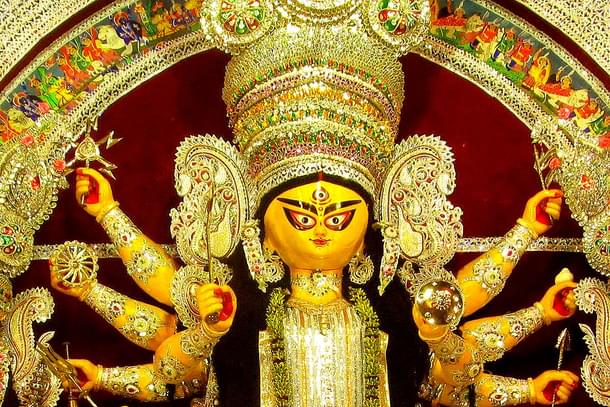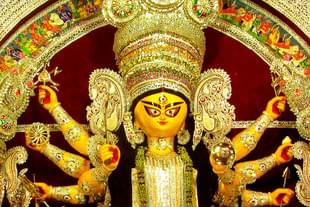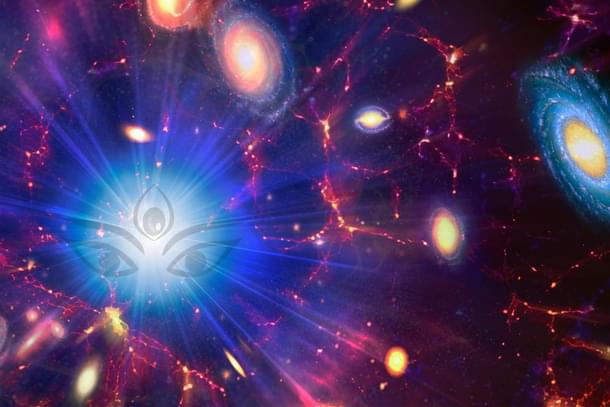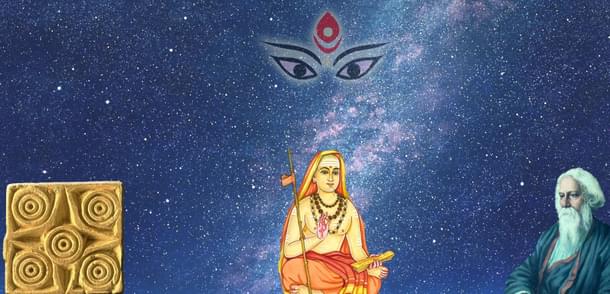Ideas
Random Meditations Through Her 1000 Names (XVIII): Because The Mother Never Blinks
Aravindan Neelakandan
Jul 20, 2020, 07:33 PM | Updated Dec 16, 2024, 02:11 PM IST
Save & read from anywhere!
Bookmark stories for easy access on any device or the Swarajya app.


Read previous part here.
The beauty of the face of the Goddess is not static. It is always changing. Every moment it is changing.
So, the beauty of her face, so dynamic, makes it look like a small moving river of beauty. In that flow of beauty there are two fishes which are frolicking, adding to the dynamic grace of her face. These fishes are her two eyes.
So, the next name calls her as the one with the eyes which are fishes playing in the beauty of her face - Vaktralakshmi-parivaaha-chalanminabha-lochana.

The eyes being like the fish not only means that her eyes are ever moving—looking everywhere—but it also means that they do not wink.
They look everywhere, at every instant of time.
She is the Mother and hence, she has to take care of all existence, every moment of time.
A question may arise here.
It is well-known that in the Puranic lore, the devas or the celestial species have as their characteristics, wink-less eyes.
Perhaps the wink-less eyes of the devi also come from her non-human celestial nature?
The answer is a definite 'no'.
This makes her distinct from the celestial beings like the devas.
In fact, the 281st Name in the Sri Lalita Sahasranama, ‘Unmeshanimishotpanna Vipanna Bhuvanavalih’ points out this aspect: She winks and in that wink, Existence—with all the beings and non-beings in them, including the Puranic devas; infinite forms of life; various modes of evolution; often known as well as unknown varieties of matter from anti-matter to dark-matter; parallel universes; oscillating universes and multiverses along with their universal constants; time, symmetrical and asymmetrical; including the event horizons of countless black-holes, not to speak of the Puranic worlds and other realms inner and outer—the Existence that contains all these, gets dissolved and is reborn again.
The involution and evolution of entire forms and names in the fullest are linked to her winking. When her eyes do not wink is when they sustain the Universes.
So, to us humans, a relatively younger sentient species evolved out of the matter in this small planet orbiting a mediocre yellow sun lost in the infinite magnitude of galaxies, her eyes remain wink-less, sustaining the universe as we understand it.
This protective nature of her wink-less eyes is brought about in the Saundarya Lahari of Adi Sankaracharya thus:
Daughter of the king of Mountains! Seers reveal that the universe goes through dissolution and emergence by wink of Your eyes. But, I think that the whole universe is protected by You keeping Your eyes from winking (parihrta nimesas)Saundarya Lahari verse 55
For Indians of southern India, the mention of the wink-less eyes at once evokes Meenakshi of Madurai whose name itself means the fish-eyed Goddess.
In chaste classic Tamil, she is called 'Ankayarkanni', the beautiful fish-eyed goddess.
Tamil Bhakti tradition also praises her eyes' wink-less nature as not just being ever protective and but also nurturing (pertaining to the traditional belief that the fish nurtures her young ones with her mere gazing at them).
In the commentary of Sri Lalitha Sahasranama, the nurturing nature of her fish-like eyes is emphasised.
The imagery of wink-less eyes goes back, as most pan-Indian spiritual images and metaphors do, to the Vedas.
The unwinking eyes are related to Varuna in the Vedas.
Historian and archaeologist, Parveen Talpur, in her book ‘ndus Seals (2600-1900 BCE) Beyond Geometry (2017) while studying the Kot Diji Phase Button Seal from Harappa (H-1535) refers to the suggestion of Indologist Asko Parpola 'that the circle with a dot motif represents eye'.
She then points out that Varuna eternally watches his subjects from the skies through the stars which are his thousand-eyes. 'Furthermore, Parpola compares gods’ eyes with fish eyes, as both are unwinking', writes Dr Talpur. Varuna also has a motherly nature as well. 'Varuna is the womb' says the Satapatha Brahmana (12.9.1.17).

After Adi Sankaracharya and countless Bhakti poets, the unwinking eyes of the Goddess again reveal themselves in the fourth stanza of Gurudev Rabindranath Tagore’s five-stanza poem, the famous Bharoto Bhagyo Bidhata, the first stanza of which forms India’s national anthem.
Here, the poet speaks about the difficult times the people may face - the dark night enveloping the nation. Even there, in such dark testing times, he discovers that the ‘auspicious, ever-wakeful, downward looking wink-less eyes’ of the Mother providing protection: 'Jagrata chila tava avicala mangala natanayane animese Duhsvapne atanke raksha karile anke Snehamayi tumi Mata'.
So, here is the name that calls her eyes as the moving fish in the dynamic beauty of her face. Contained in it is a vision that allows us to glimpse her unimaginable, unreachable, grandeur and her ever-ready motherly love and concern.
Aravindan is a contributing editor at Swarajya.





